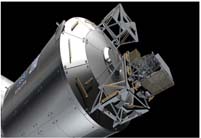
The European Space Agency (ESA) receives on Tuesday in Valencia the latest space technology to observe the most violent phenomena in the atmosphere. It is about the ASIM project, an observatory designed and built in Spain under the leadership of the UV and the National Institute for Aerospace Technology (INTA), through which INTA aims to respond to 20 years of uncertainties about violent gamma radiation discharges on Earth.
The European Space Agency (ESA) receives on 13 December in Valencia the latest space technology to observe the most violent phenomena in the atmosphere. It is about the ASIM project, an observatory designed and built in Spain under the leadership of the UV and the national Institute for Aerospace Technology (INTA). Víctor Reglero, full university professor of Astronomy of the UV and director of the Image Processing Laboratory (IPL), in the Science Park of the academic institution, is the researcher in charge of the project.
ASIM (The Atmosphere Space Interaction Monitor) is an observatory of ultraviolet rays, x-rays and gamma rays that will be installed in the external platform of the Columbus module of the International Space Station (ISS) for the observation of the Earth’s atmosphere. Once it has been attached it will measure the phenomena registered above the heavy storms.
According to Reglero, each day more than a million rays take place, and they can be seen from the Earth. “Then, we found the Sprites, violent discharges at 40 km altitude and more difficult to observe. However, more phenomena take place and we can not see them from the Earth observatories. These are the TGF (Terrestrial Gamma Ray Flashes), highly violent discharges of High-Energy X and Gamma of very short duration: 0,001 seconds. These are very estrange. Only one per day can be detected”, says Reglero.
Thanks to the implementation of the ASIM, the problem of detecting TGF will be solved, so they could be located with an improved accuracy of 3,600 times (from 400x400 km to 5x5 km).
The violent discharges of High-Energy of our atmosphere, are they associated with storms and rays? Why are they so scarce regarding to rays? Where are they generated? How do they propagate? What generates this extremely high radiation, similar to those of the black holes? These are questions that have been looking for answers for more than 20 years. “With ASIM we may obtain answers to these uncertainties at the end of 2017”, says Reglero.
Development and production of the project
ASIM was born in 2005 in the conceptual design stage. Two years before, it was developed the design in detail and in 2010 the works for the creation of models and redesigns of the optical, mechanical and thermal systems of High-Energy were started. The production of the instruments started in 2015.
The optical system was developed in the Aciturri enterprise of Burgos (Spain). The mechanical components of ASIM were developed in the facilities of Trinos Vacuum, in Paterna (Valencia, Spain). Iberespacio, in Torrejón de Ardoz was in charge of the thermal components. And the industry of Cachinero de Toledo produced the containers for the instruments.
The assembly of the elements and the test were developed successfully during the first months of this year, and on 29 July ASIM was given to the European Space Agency, prepared to travel to the International Space Station.
Five companies (Aciturri, Trinos Vacuum Projects, Iberespacio, Alcupla y Cachinero) and a dozen Spanish providers take part in this project, in which 30 engineers and physicists of the UV and the INTA have also participated. Furthermore, 18 more researchers are ready to analyse data, once ASIM sends images of the most violent phenomena of the atmosphere.
During 11 years, Spanish scientists of ASIM have worked leading the essential parts of the Monitor X-ray and Gamma-ray Sensor (MXGS), the coded-mask (optical system) of ASIM is the tenth build in the world. Of these, seven have been designed and produced in Valencia. Spain is the author and responsible of the 70 per cent of the optical systems of High-Energy in the world.
https://www.youtube.com/watch?v=_68jcxkHFfA&feature=youtu.be
Last update: 12 de december de 2016 13:12.
News release



















